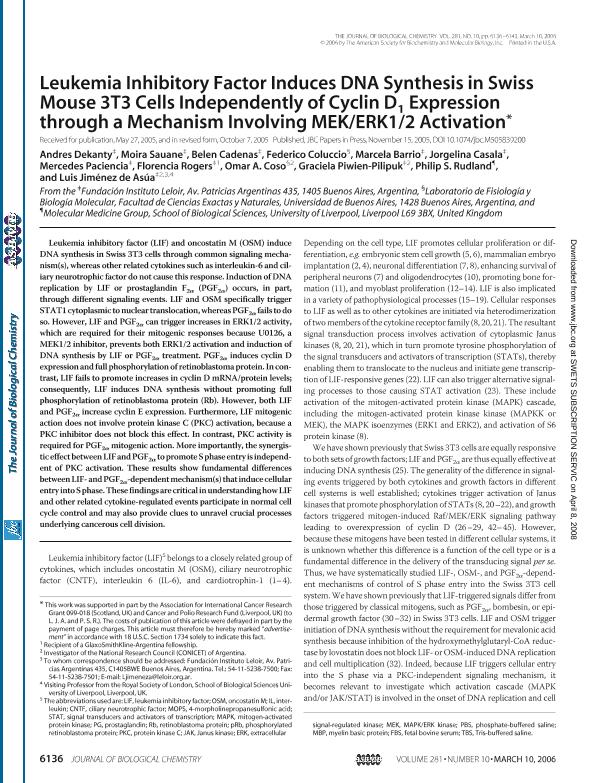Mostrar el registro sencillo del ítem
dc.contributor.author
Dekanty, Andres

dc.contributor.author
Sauane, Moira

dc.contributor.author
Cárdenas, Belén
dc.contributor.author
Coluccio Leskow, Federico

dc.contributor.author
Barrio, Marcela
dc.contributor.author
Casala, Jorgelina
dc.contributor.author
Paciencia, Mercedes
dc.contributor.author
Rogers, Florencia
dc.contributor.author
Coso, Omar Adrian

dc.contributor.author
Piwien Pilipuk, Graciela

dc.contributor.author
Rudlland, Philip S.
dc.contributor.author
Jimenez de Asua, Luis Adan Felipe

dc.date.available
2017-06-21T14:46:14Z
dc.date.issued
2006-03-10
dc.identifier.citation
Dekanty, Andres; Sauane, Moira; Cárdenas, Belén; Coluccio Leskow, Federico; Barrio, Marcela; et al.; Leukaemia Inhibitory Factor (LIF) induces DNA synthesis in Swiss mouse 3T3 cells independently of cyclin D1 expression through a mechanism involving MEK/ERK 1/2 activation; American Society For Biochemistry And Molecular Biology; Journal Of Biological Chemistry; 28; 10; 10-3-2006; 6136-6143
dc.identifier.issn
0021-9258
dc.identifier.uri
http://hdl.handle.net/11336/18518
dc.description.abstract
Leukemia inhibitory factor (LIF) and oncostatin M (OSM) induce DNA synthesis in Swiss 3T3 cells through common signaling mechanism(s), whereas other related cytokines such as interleukin-6 and ciliary neurotrophic factor do not cause this response. Induction of DNA replication by LIF or prostaglandin F2alpha (PGF2alpha) occurs, in part, through different signaling events. LIF and OSM specifically trigger STAT1 cytoplasmic to nuclear translocation, whereas PGF2alpha fails to do so. However, LIF and PGF2alpha can trigger increases in ERK1/2 activity, which are required for their mitogenic responses because U0126, a MEK1/2 inhibitor, prevents both ERK1/2 activation and induction of DNA synthesis by LIF or PGF2alpha treatment. PGF2alpha induces cyclin D expression and full phosphorylation of retinoblastoma protein. In contrast, LIF fails to promote increases in cyclin D mRNA/protein levels; consequently, LIF induces DNA synthesis without promoting full phosphorylation of retinoblastoma protein (Rb). However, both LIF and PGF2alpha increase cyclin E expression. Furthermore, LIF mitogenic action does not involve protein kinase C (PKC) activation, because a PKC inhibitor does not block this effect. In contrast, PKC activity is required for PGF2alpha mitogenic action. More importantly, the synergistic effect between LIF and PGF2alpha to promote S phase entry is independent of PKC activation. These results show fundamental differences between LIF- and PGF2alpha-dependent mechanism(s) that induce cellular entry into S phase. These findings are critical in understanding how LIF and other related cytokine-regulated events participate in normal cell cycle control and may also provide clues to unravel crucial processes underlying cancerous cell division.
dc.format
application/pdf
dc.language.iso
eng
dc.publisher
American Society For Biochemistry And Molecular Biology

dc.rights
info:eu-repo/semantics/openAccess
dc.rights.uri
https://creativecommons.org/licenses/by-nc-sa/2.5/ar/
dc.subject
Lif
dc.subject
Pgf2alpha
dc.subject
Osm
dc.subject
Mapk
dc.subject.classification
Medicina Critica y de Emergencia

dc.subject.classification
Medicina Clínica

dc.subject.classification
CIENCIAS MÉDICAS Y DE LA SALUD

dc.title
Leukaemia Inhibitory Factor (LIF) induces DNA synthesis in Swiss mouse 3T3 cells independently of cyclin D1 expression through a mechanism involving MEK/ERK 1/2 activation
dc.type
info:eu-repo/semantics/article
dc.type
info:ar-repo/semantics/artículo
dc.type
info:eu-repo/semantics/publishedVersion
dc.date.updated
2017-05-16T20:33:09Z
dc.journal.volume
28
dc.journal.number
10
dc.journal.pagination
6136-6143
dc.journal.pais
Estados Unidos

dc.conicet.avisoEditorial
This research was originally published in Journal of Biological Chemistry 2006; 281:6136 –6143 © the American Society for Biochemistry and Molecular Biology.
dc.description.fil
Fil: Dekanty, Andres. Fundación Instituto Leloir; Argentina. Consejo Nacional de Investigaciones Científicas y Técnicas; Argentina
dc.description.fil
Fil: Sauane, Moira. Fundación Instituto Leloir; Argentina
dc.description.fil
Fil: Cárdenas, Belén. Fundación Instituto Leloir; Argentina
dc.description.fil
Fil: Coluccio Leskow, Federico. Universidad de Buenos Aires. Facultad de Ciencias Exactas y Naturales. Departamento de Fisiologia, Biologia Molecular y Celular. Laboratorio de Fisiologia y Biologia Molecular; Argentina. Consejo Nacional de Investigaciones Científicas y Técnicas; Argentina
dc.description.fil
Fil: Barrio, Marcela. Fundación Instituto Leloir; Argentina
dc.description.fil
Fil: Casala, Jorgelina. Fundación Instituto Leloir; Argentina
dc.description.fil
Fil: Paciencia, Mercedes. Fundación Instituto Leloir; Argentina
dc.description.fil
Fil: Rogers, Florencia. Fundación Instituto Leloir; Argentina
dc.description.fil
Fil: Coso, Omar Adrian. Universidad de Buenos Aires. Facultad de Ciencias Exactas y Naturales. Departamento de Fisiologia, Biologia Molecular y Celular. Laboratorio de Fisiologia y Biologia Molecular; Argentina. Consejo Nacional de Investigaciones Científicas y Técnicas; Argentina
dc.description.fil
Fil: Piwien Pilipuk, Graciela. Fundación Instituto Leloir; Argentina. Consejo Nacional de Investigaciones Científicas y Técnicas; Argentina
dc.description.fil
Fil: Rudlland, Philip S.. University of Liverpool; Reino Unido
dc.description.fil
Fil: Jimenez de Asua, Luis Adan Felipe. Fundación Instituto Leloir; Argentina. Consejo Nacional de Investigaciones Científicas y Técnicas. Oficina de Coordinación Administrativa Parque Centenario. Instituto de Investigaciones Bioquímicas de Buenos Aires. Fundación Instituto Leloir. Instituto de Investigaciones Bioquímicas de Buenos Aires; Argentina
dc.journal.title
Journal Of Biological Chemistry

dc.relation.alternativeid
info:eu-repo/semantics/altIdentifier/url/http://www.jbc.org/content/281/10/6136.long
dc.relation.alternativeid
info:eu-repo/semantics/altIdentifier/doi/http://dx.doi.org/10.1074/jbc.M505839200
Archivos asociados
